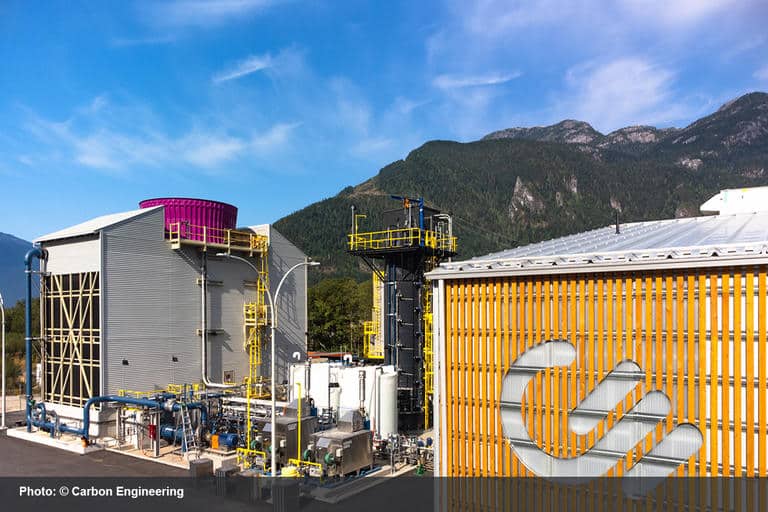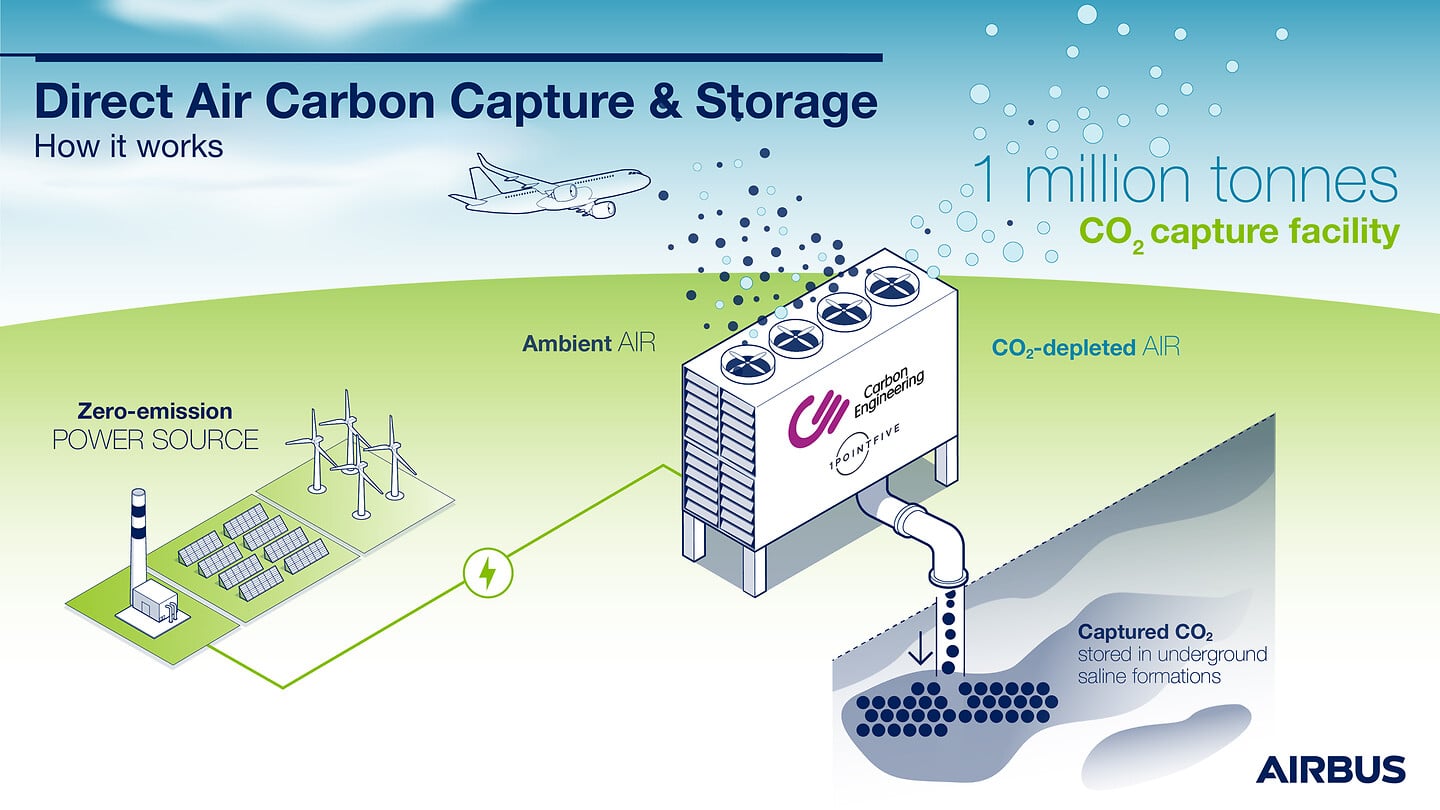Aerospace
Airbus and Seven airlines have signed letters of intent to look into aviation carbon removal systems.
Seven airlines have joined the airbus company’s effort to reduce the amount of carbon in the environment. The initiative will lower the carbon footprint and utilise the leftover energy for various uses. #Airbus #CO2 #carbon-remove

Letters of Intent (LoI) have been signed by Airbus and several significant airlines, including Air Canada, Air France-KLM, easyJet, International Airlines Group, LATAM Airlines Group, Lufthansa Group, and Virgin Atlantic, to investigate the possibility of a future supply of carbon removal credits from direct air carbon capture technology.
A high-potential technique called Direct Air Carbon Capture and Storage (DACCS) filters and removes CO2 emissions directly from the air using powerful fans. The CO2 is safely and permanently stored in geologic reservoirs after being taken out of the atmosphere. A direct air carbon capture and storage solution would enable the aviation industry to recover the same amount of emissions from its activities directly from the atmosphere since the sector is unable to capture CO2 emissions emitted into the sky at source.
- DACCS: how it works
What many people might consider science fiction is quickly becoming reality. A number of sectors could be able to reach their net-zero carbon emissions goals with the aid of Direct Air Carbon Capture and Storage (DACCS), which captures CO2 caused by human activity straight from the atmosphere. It is emerging as a possible complementary solution to sustainable aviation fuel and hydrogen for hard-to-abate industries like aviation.
This is a direct air capture facility through which hundreds of tonnes of carbon are being drawn in from the air. Here, in the year 2030 and in the heart of the Lone Star state, this spectacular creation is now a key bastion in the fight against climate change and the world’s transition to a net-zero energy system.
- Used to create fuels like Power-to-Liquid through a complementary process called AIR TO FUELSTM.
A direct air capture facility, or DAC for short, functions like a massive, extremely effective tree by sucking air from the environment and removing any CO2 that is present in it. There will probably be dozens of them all around the world in 2030. But moving forward to the present, this technology is still in its infancy.
To remedy this, Carbon Engineering is working. At its pilot facility in Squamish, Canada, the Canadian company developed a direct air capture technology, and it is now aiming for widespread adoption. These facilities are being developed on a megaton scale both in the US and other countries by 1PointFive, Carbon Engineering’s licenced US partner. The Permian Basin’s DAC project, which is scheduled to start operating in 2024, will eventually be able to capture up to a million tonnes of CO2 annually. This essentially equates to the labour or capacity for absorption of 40 million trees.
The pure CO2 that has been gathered can then be either stored underground or used to create fuels like Power-to-Liquid through a complementary process called AIR TO FUELSTM. In the former, sometimes referred to as carbon storage or sequestration, CO2 is injected into salt deposits more than a kilometre below the surface of the planet. Therefore, CO2 is securely and permanently deposited underground.
-
Introducing scalable, affordable carbon removal technologies for aircraft.
The aviation sector adopted the long-term climate goal of having net-zero carbon emissions by 2050 in October 2021. To accomplish this, a variety of decarbonization strategies, including technological advancements in aircraft design, new fuels like hydrogen and SAF, efficiency gains in airport operations and air traffic management, and market-based measures, have all been identified. However, they won’t be enough on their own to bring aviation’s CO2 emissions down to the necessary levels.
The Intergovernmental Panel on Climate Change (IPCC) claims that extracting CO2 from the atmosphere will also be required if the world is to reach net zero emissions by 2050. Additionally, direct air capture is necessary because hard-to-reduce industry like aviation cannot remove their pollutants at the source.
To provide carbon reductions via direct air capture technology to the aviation industry, Airbus has teamed with 1PointFive. In fact, as part of an initial offtake, Airbus has pre-purchased 100,000 tonnes of carbon reductions annually from 1PointFive for four years, totaling 400,000 tonnes.
In order to promote direct air capture as a crucial method of reaching the industry’s net-zero target, several airlines have expressed interest in working with Airbus in this area. Partnerships like these, which bring together important stakeholders from both inside and outside the industry, will be crucial to bringing climate-neutral air travel ever closer to reality as the aviation sector continues to improve its course towards net zero.

Aerospace
When Ratan Tata was denied entry to the airfield at the Aero India show, he waited

During our visit to Aero India 2019, we had the unexpected opportunity to see Ratan Tata at the event, which was a thrilling moment for us. However, there was a surprising hiccup when the security staff didn’t allow him to enter due to a lack of a security pass.
Despite this, he remained calm and patiently waited for about 20 minutes until a member of the Tata team brought him the required pass, after which he calmly proceeded inside. It was a humbling sight, showcasing his composed demeanor even in such situations.
Ratan Tata ji is not only a renowned industrialist but also a trained pilot, holding a pilot’s license. In 2007, he became the first Indian civilian to fly the F-16 Falcon during the Aero India show in Bangalore—a proud moment for the nation.
His passion for aviation extended beyond flying, as he played a key role in shaping India’s aerospace industry. Under his leadership, Tata ventured into manufacturing and maintaining aerospace components while upholding its legacy of quality. Notably, Tata’s collaboration with Airbus to develop and manufacture the C295 aircraft is a testament to its growing influence in the sector.
-

 Aviation2 months ago
Aviation2 months agoMicrosoft Flight Simulator Raises $3 Million to Bring Back the An-225 Mriya
-

 Airlines2 months ago
Airlines2 months agoQantas Engineers Stage Walkout Over Cost of Living Concerns
-

 Airlines2 months ago
Airlines2 months agoQatar Citizens Can Travel to the United States Without a Visa
-

 Aviation2 months ago
Aviation2 months agoQatar Airways bans these new Electronic Devices on plane
-

 Airlines2 months ago
Airlines2 months agoJapan Airlines Rolls Out Free Domestic Flights to International Passengers
-

 Defence2 months ago
Defence2 months agoWhich Country Has the Largest Fleet of Fighter Aircraft?
-

 Airport2 months ago
Airport2 months agoWestern Sydney Airport Welcomes Its First Plane After 6 Years of construction
-

 Aviation2 months ago
Aviation2 months agoDid you know ? Once Boeing 747 carried 1088 passenger in 1991










